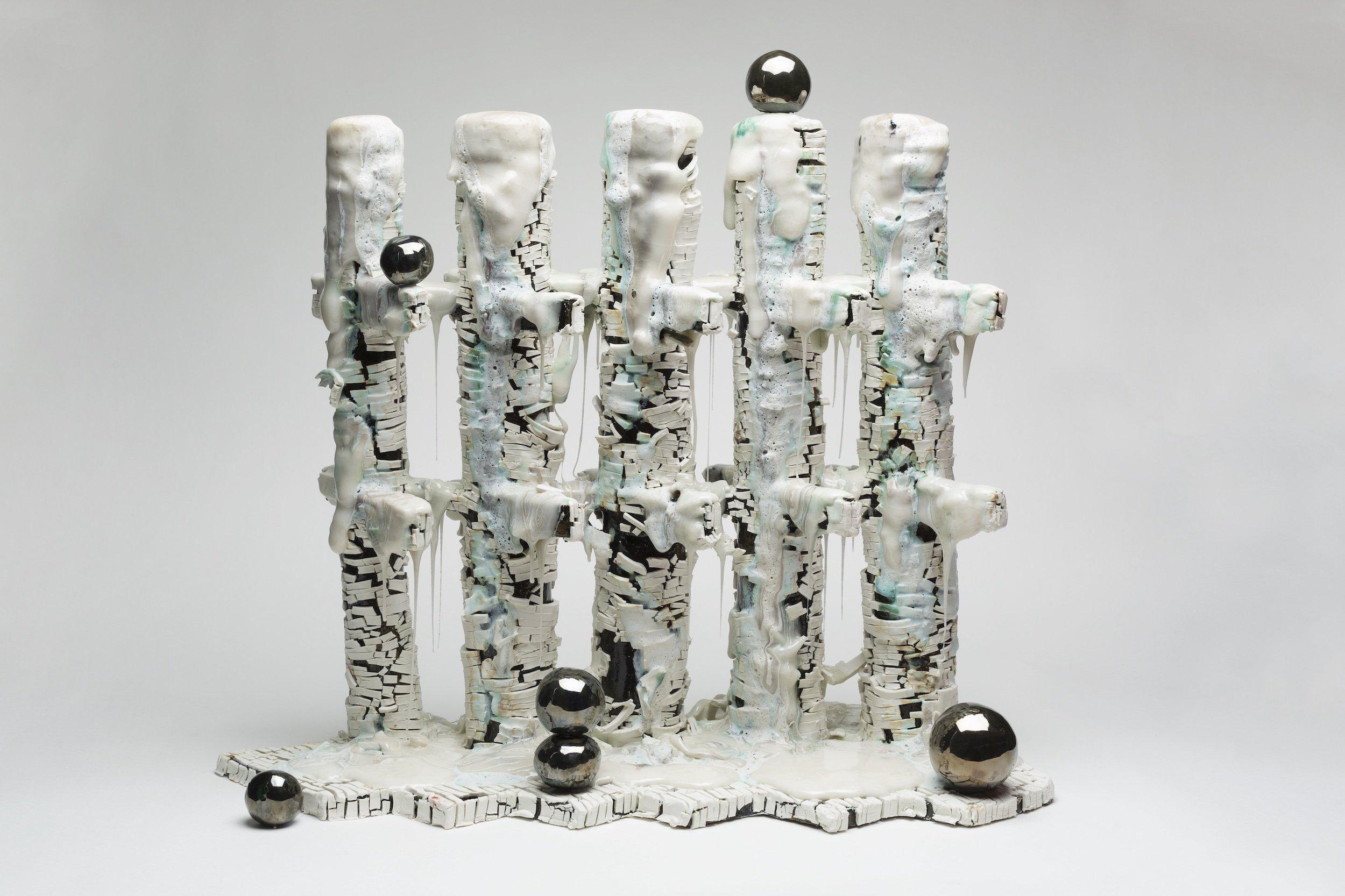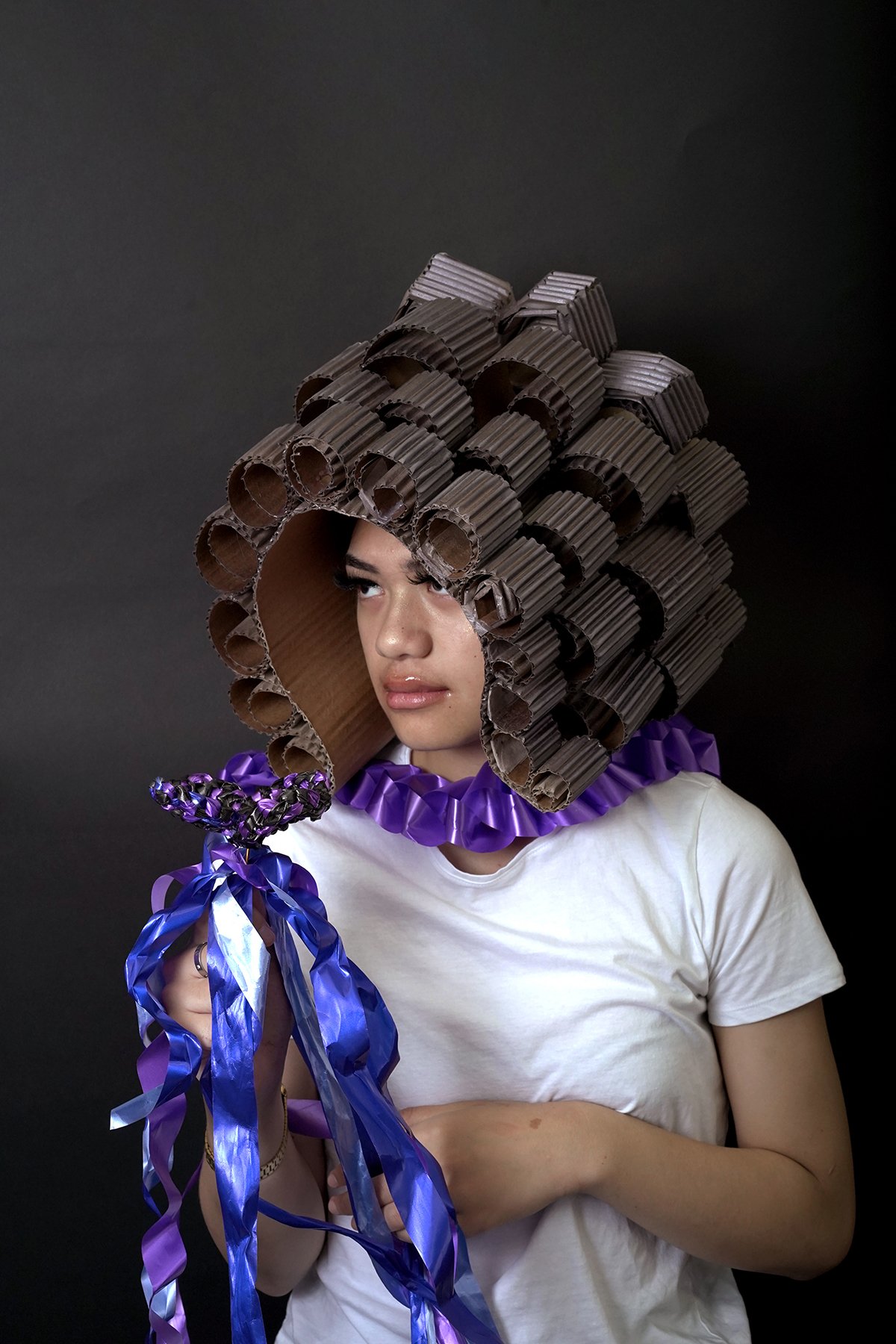Ornery and Opulence: In the thrall of Andrea du Chatenier’s ceramics
Commissioned by Sarjeant Art Gallery Te Whare o Rehua Whanganui and republished on the occasion of du Chatenier’s exhibition Elephant’s Ear at Anna Miles Gallery, through 3 November 2022.
The colour of dank dirt that gives life to Aotearoa’s native bush and the grey-green of dry blistered lichen has become our national dress code. According to some this dour sobriety likewise permeates the condition of our interior lives. Western intellectual piety views synthetic colour as either cosmetic, vulgar, infantile or pathological. Rigidity, of the relaxed sort, is a key marker of our local cultural demeanour. Children are routinely castigated for being too loud and unruly. Vivid colour, without pharmaceutical enhancement or religious inducement, is rarely countenanced outside Pacific Island communities. A palette that draws redemption from a confectionary shop rather than native bush walk, invites us to riot, imbibe and swoon at the saccharine syrup of overly ripened fruit.
Andrea du Chatenier’s gobby forms in iridescent colour are a rude retort to serious, intellectual cool. There is little local precedent for such idiosyncratic objects made of clay. The artist banishes dribbly metaphors of nature, lumpen faux-primitive reimaginings of colonial history, and the rusticated Zen of Anglo-Oriental tableware. Her objects similarly eschew any connection to the rarefied airs of European porcelain and other such ceremonial objects made in clay. If any obligatory reference might be detected, it is to Ken Price and Ron Nagel, those rogue American West Coast ceramic practitioners who emerged during the 1960s.
The inspiration for these works is primarily about the affordances of clay as a material. Du Chatenier is more likely aligned with Sponge Bob Square Pants and their drug crazed encounters with the architectural musings of Piranesi. The artist has said:
Andrea du Chatenier, red tree, 2020. Courtesy of the artist and Sarjeant Art Gallery Te Whare o Rehua Whanganui
It is to do with being absorbed in properties. It might be gardening or cooking, but it is the ability for people to find involvement in ‘doingness’, and I find it with clay. I think the rise and fall of ceramics is a style thing. The 80s ushered in Arcoroc. The slick look of Italian-made was everywhere and the handmade went out the window. I was attracted to the unfashionableness of it, but when I started working with clay, I found the sheer volume of possibilities in it as a material. It seemed ripe for re-invention and reinterpretation. I like discarded things, fallen from grace.
Du Chatenier offers an essay in ceramic calisthenics, a bounty of exploding pustules in viscous rapture, quite simply, oodles of goo and ooze. Slowly one begins to appreciate the consummate mastery in getting the brown wet muddy stuff under control. The feel of suspended fluid in some form of arrested entropy has many latent associations with bodily functions, but in viewing these works, visual levity and effervescence persists. You get the sense of the artist chuckling to herself throughout her day. What comes through is an inscrutable wit without a need to rely on the heft of irony or sarcasm. High adrenaline and sturdy commitment to endlessly wrangling material are applied.
These ceramics defy convention. They are made not to be touched, but to be visually felt. The eye is the organ that delivers an appreciation of haptic experience. Du Chatenier’s works are also designed to do their bidding through the acidic glare of a screen. What they do is not so much ‘kiss the eye’, but pillage and sack it of all righteousness. The artist’s ultimate goal is a sense of synaesthesia, where the neurological wiring becomes crossed; smelling colour or tasting sound. Some suffer this clinically known malady continuously, but within the psychically-insulated world of contemporary art, the effect induces an irrepressible desire to lick one of these ceramic confections or disconcertingly munch down.
A simple conceit governs the logic by which du Chatenier’s ceramic forms are assembled. She organises a series of cartoon-like encounters: boxy and blobby; the textured against silky smooth. The artist readily recalls the one formal lecture given by her Sculpture instructor during the course of her degree. ‘Plane, line and full stop’, was all that was deemed necessary to inform sculpture students of what they needed to know. Take a flat plane, poke a stick through it, make a line, then poke a hole to make a full-stop. Anything beyond that was up to students to figure out for themselves.
Many of our current conversations are clouded in a morass of morality. Our experiences of art made in our time seem mostly to involve a quotient of guilt and the scrunching of sweaty brows. Ever increasing disparities in wealth distribution, unsustainable growth in population and dwindling planetary resources are the background to our consumption of contemporary art. Into this maelstrom enters an artist who claims, “Now it’s just me and the clay.”
Du Chatenier is an educator, aware of the potential flippancy of her remark. She says:
My previous work was always about some allusion to or subversion of political content —Now I might be subverting expectations of clay. I can’t be bothered, I am too entertained by this material, although I would say, the works refer to gender-specific experience. That over-indulgence in surface over form is an inescapable aspect of growing up female. ‘Form’ was always a masculine concept. Surface was defined as a type of feminine dress or skin. Surface is something that is so changeable. It is about glamour or ‘glamming’, manipulating to alter the fact.
The intellectual essentialism that claims art should now consist of little other than crowd-congenial acts of social importance is bequeathed to us by 1960s American minimalism and conceptual art. This point means very little to those who have not witnessed the various institutional discourses tasked with figuring out the value of intellectual critique. In her capacity as a tertiary educator, du Chatenier is more than familiar with the role intelligence might assume for itself within a formal artistic setting.
This situation is troubling and difficult to discern, but can be related to the diminishment of craft skills within the culture and economy. Conceptual modes of practice have long since surpassed craftsmanship as a core competency within the academy. Practical and manual skills (digital or not) have been disavowed. The cumulative capacity of technology is now supplanting lived sensory experiences in that much of our practical interaction with the world is now digitised. The time to learn, to look, accumulate, and do nothing, is now calculated in terms of internet speed and data transfer. Those capable of practically fixing stuff are endangered, as little these days is ever manufactured with the intention of being fixed.
This historic cluster of sorts, offers no sense. The neo-noire sci-fi cinema classic, Blade Runner (1982) was notable for showing us, without the use of digital technology, a completely synthetic and artificial realm. Now considered a historical moment in cinema, this was an all-neon dystopian potboiler. Viewing with unsoiled and unvarnished eyes, this unfamiliar screen-world required a new aesthetic sensibility. The same claim could have been made just as easily for the campy and vampy sci-fi film Metropolis, produced 55 years earlier. As these examples show, every generation needs its moment to reconcile the alien and the exotic.
Have we suppressed the jungle ‘gestalt?’ Childhood was where we looked daily to the gratuitous pursuit of mindful joy and aesthetic pleasure. This was, to an extent, the measure of what it means to be alive: Something irreducible to and irrecuperable from language; Something that ignited the nervous system to leap from our bodies. Such a philosophy is now either barely recognised or condemned as aesthetic libertarianism.
As we move to expose new conditions of ‘thingness’, the notion of the ‘aesthetic’, with its troublesome insinuations of connoisseurship, may need to be considered anew. Where the ‘aesthetic’ once stood for a transcendent category related to beauty, it now looks to accommodate the heterological and the idiosyncratic, giving further detail to our understandings of material culture and its affects in and on our bodies. It is a challenging time to make critical assertions. Perhaps the best we can hope for is to continue to bear witness.
Andrea du Chatenier’s ceramics revel in their material condition. No climate considerations or catastrophizing of human collectivity are brokered. No empathy born from a desire to speak on behalf of the disenfranchised and oppressed is exercised, rather what we have here is an aesthetic and material practice, whose virtue is to tug away at those cerebral recesses, those places where phantasmagoric dreaming and the imaginative doings of Dr Seuss still lurk. I’m all too happy to swoon in thrall of the graphic rancour and bacchanalia that Andrea du Chatenier’s ceramics celebrate.
Richard Fahey, “Ornery and Opulence: In the thrall of Andrea du Chatenier’s ceramics", from Eigenleben: Andrea du Chatenier new ceramic works, published by du Chatenier and Sarjeant Art Gallery Te Whare o Rehua Whanganui, 2020
Andrea du Chatenier, Arctic fortress, 2020. Courtesy of the artist and Sarjeant Art Gallery Te Whare o Rehua Whanganui
Andrea du Chatenier, tethered astroid, 2020. Courtesy of the artist and Sarjeant Art Gallery Te Whare o Rehua Whanganui
Andrea du Chatenier, aa Sunset, 2020. Courtesy of the artist and Sarjeant Art Gallery Te Whare o Rehua Whanganui









Commissioned by Sarjeant Art Gallery Te Whare o Rehua Whanganui and republished on the occasion of du Chatenier’s exhibition Elephant’s Ear at Anna Miles Gallery, through 3 November 2022.